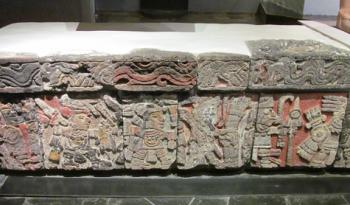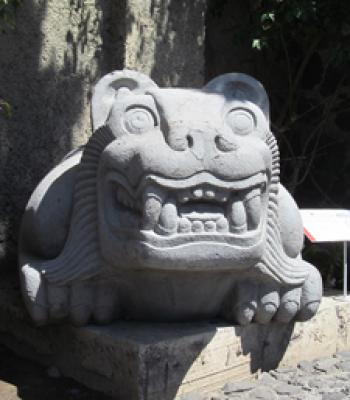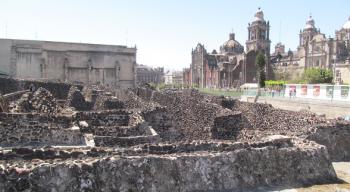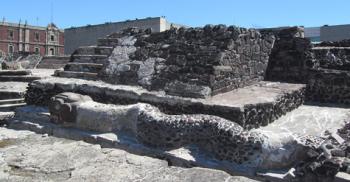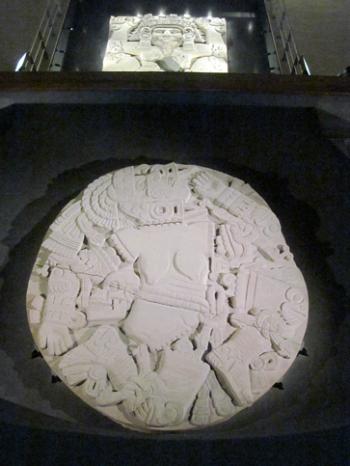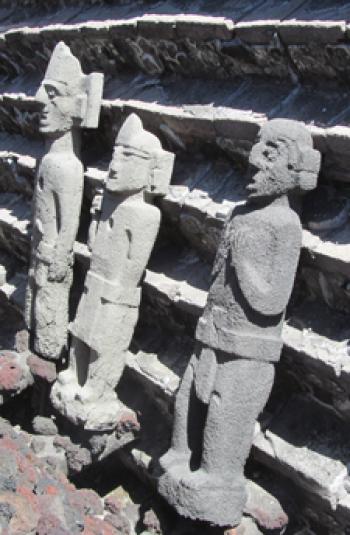Templo Mayor, Great Temple of the Aztecs
This item appears on page 45 of the October 2019 issue.
There is an old adage that “all roads lead to Rome.” It’s a statement with much truth in it, since most, if not all, roads in the early centuries of the Christian era did lead to Rome, then the center of a vast, far-flung empire.
The same adage could be applied to 14th-century Tenochtitlán, then the center of the Aztec empire in Mesoamerica. All roads seemed to lead to Tenochtitlán. Or at least they did from AD 1325 to 1521.
Before then, the Aztecs were a nomadic tribe that migrated from a place they called Aztlán, somewhere in northern or northwestern Mexico. Some archaeologists speculate that they may even have come from what is now the southwestern US. In any case, they arrived in the Valley of Mexico in the central part of the country probably sometime in the early to mid-13th century AD.
The traditional date for the founding of the Aztec capital, Tenochtitlán, is AD 1325. Located in marshy Lake Texcoco, Tenochtitlán occupied a small island connected to the mainland with causeways. Roads led from all parts of the expanding Aztec empire to Tenochtitlán and to the sacred precinct where the Aztec rulers erected twin shrines atop a pyramid dedicated to two of their most powerful gods, Tláloc and Huitzilopochtli.
These twin shrines were their Templo Mayor, or Great Temple. As the empire grew, new pyramids were erected over old ones until there were seven pyramids, one atop the other.
All this ended — both empire and pyramid building — with the arrival of Hernán Cortés and his band of conquistadores in 1519. Within a few years, the Spaniards had conquered the Aztecs and begun the destruction of the Great Temple within the sacred precinct. Over the next four centuries, Mexico City rose over the ruins of the Aztec empire.
Discovery
Even the exact location of the Great Temple was lost until 1978, when electrical workers uncovered the great stone disk of the Aztec goddess Coyolxauhqui. This discovery was the impetus that led to the rebirth of the ancient Aztec sacred precinct with its crowning glory: the Great Temple with its twin shrines.
Today, visitors can walk around and through what was once the center of the Aztec world. The visit begins on the side of Mexico City’s Metropolitan Cathedral on the Zócalo, the city’s main square.
Layers of history
From the Templo Mayor’s Visitors’ Center, where there’s a model of the site, a walkway passes through the ruins of two centuries, layer upon layer, of the sacred precinct. These layers are especially visible at the beginning of the walk, where you can clearly see where one pyramid had a newer one superimposed over it.
As you walk, look for the serpent-head sculptures on the sides of the staircases and for writhing stone serpents nearby.
You also pass a replica of the stone disk found in 1978, depicting Coyolxauhqui decapitated and dismembered. This goddess was defeated in battle by her brother Huitzilopochtli and thrown off Coatépec Hill, a sacred mountain in the Aztec religion.
The huge disk was found in this location, at the base of the twin shrines to Tláloc and Huitzilopochtli. Perhaps it was symbolically placed there to represent the goddess’ defeat and subsequent fall.
A few feet away lie several replicas of standard bearers propped up against the steps of one of the early pyramids. Notice the small cavity in each statue’s chest that may once have held a precious stone.
Twin shrines
Just beyond are the twin shrines that crowned the pyramid. They belong to one of the earliest pyramids to be erected at the site, probably around 1390. The one on the right was dedicated to Huitzilopochtli, one of the primary Aztec gods, associated with war and power. This god’s importance is not surprising, considering how quickly the Aztecs conquered and subjugated their neighbors after their arrival in central Mexico.
The shrine on the left was dedicated to Tláloc, the god associated with rain and agriculture. There is a chacmool, a reclining stone figure with a bowl on its chest, in front of Tláloc’s shrine. The bowl may once have held the hearts of victims sacrificed atop this pyramid.
Eagle warriors
As you walk, you have more glimpses of staircases, stone serpents and smaller temples until you reach the complex called the House of the Eagle Warriors, where two stone eagle heads flank a short staircase.
Inside the complex are banquettes carved with figures of richly dressed warriors marching single file. (These can be viewed from the walkway; visitors are not allowed inside.) Much of the original color is still visible on the figures.
Past the House of the Eagle Warriors, visitors can glimpse the tzompantli with stuccoed stone skulls. The Aztecs displayed actual human skulls on racks within the sacred precinct. The skulls were those of sacrificed enemy warriors.
Museum
The walkway through Aztec history ends in the site’s museum. It’s full of objects found during excavation.
You shouldn’t miss the tzompantli as you enter the museum or the life-size ceramic statue of an eagle warrior found in the complex of the same name, not to mention the originals of the standard-bearer statues.
But the museum’s highlight is the disk whose discovery started it all, the monolith showing the broken body of Coyolxauhqui.
If you go…
Templo Mayor is open from 9 to 5, Tuesday to Sunday (closed on Monday). The entrance fee is 75 pesos, about $3.75 at the time of our visit. Allow at least 60 to 90 minutes for the outside stroll and another hour or two for the museum.
Pair a visit to the Templo Mayor with a visit to the spectacular National Museum of Anthropology (about a 20-minute cab ride away), not necessarily on the same day. The Mexica hall in this museum features objects from both the Aztecs and predecessor cultures, including the Teotihuacanos and the Toltecs. This museum, too, is open 9 to 5, Tuesday to Sunday. Admission costs 75 pesos.
For our 16 nights in Mexico City in February 2019, my husband and I rented a wonderful apartment through Airbnb (www.airbnb.com/rooms/plus/17559260).
Located on Avenida Amsterdam in the classy Condesa/Hipódromo neighborhood, the apartment had a combination living/dining room, a large kitchen with dishwasher, microwave and huge fridge, a separate laundry room, two bedrooms and two bathrooms.
What made this apartment stand out was the beautiful large terrace overlooking leafy Avenida Amsterdam plus its elegant furnishings, 24-hour doormen, the neighborhood, the abundance of nearby restaurants and the apartment owner, one of the most accommodating we’ve ever met. A very special place, we felt!
The rental price for the 16 nights was $2,448, about $153 per night.

